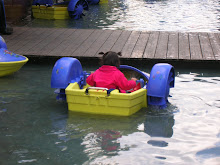Ok, so I didn't actually go the the province of Tibet, but I'm on the Tibetan plateau with an 80% Tibetan population, and it seems like many people don't speak Chinese. I've had a pretty Tibetan last few days.
Monday, we went out to eat with two of Matt Ho's Tibetan students. Both are from Tibetan areas in Sichuan province. Adam is a nomad, whose family moves their yak herd every season to a new pasture in the valley they share with 100 other nomad families. They eat zampa, yak, home-made yogurt, and yak-butter tea. No veggies. Jimyang is from a bigger town in the same area. Both want to teach English in the future, and their speaking skills are very good. Sounds like a lot of Tibetan students also want to be tour guides for foreigners. The food we got was delicious. The yak meat, which is absurdly tough and hard to eat, was polished off clean to the bone. Fat, sinew, tendons and all. We also had rice with yogurt of little baby yams. And zampa. Zampa is barley flour, which is the primary crop in here in Qinghai. Tibetans eat this pretty much every day. You take some yak butter and put it in a bowl with warm tea. Then you add the zampa and either some sugar or yak cheese (which is hard as a rock--a little dissapointing for the cheese lover in me) and mix it carefully with your hands. I was really bad and spilled a lot on the table, but the Tibetans were pros. In the end, you have a large lump of the zampa, which is basically delicious cookie dough and you eat it. Pretty good. And it expands in your stomach so keeps you full for a long day of work.
Tuesday morning, Matt and I departed for the Tibetan town of Rebkong (Chinese name: Tongren) some 4 hours SE of Xining by a rickety old bus. It stopped a lot to pick up people, drop them off, re-fuel, have snack people sell things, etc. The road was very mountainous and windy, and there was a lot of construction. It actually seemed like they built the road in 200 meter segments with a 10 meter gap in between that the bus had to slow down to cross.
We visited the monastery at Wutun Si, which is famous for it's Tibetan thangkas--a religous kind of painting. After looking lost for a while, some monks guided us to where we bought tickets, and we were shown around by one of them. First, we entered a prayer hall where the monks were seated in lone lines in a dimly lit room, and were chanting. It was amazing. Sometimes, they would stop and one would go on in a deep, scratchy voice, before the others would rejoin, often using bells. The boy monks (ages ~8) were much more interested in giggling at us than at chanting.
We saw some other temples, all beautifully ornate and filled with people praying (from age 4 to 80). On the way out, we met a monk who was the thangka painting teacher, and he invited us to his house. The monks all live on the premise in small houses that are enclosed in with a courtyard. We entered his house, and he poured us tea and showed us pictures on his computer. He spoke a lot about Tibet and how the Chinese government treats the people, and the way they are discriminated against. He was pretty passionate about it, unsurprisingly. Unfortunately, our Chinese was not good enough to understand most of it, but we got the jist. And he had a really cute little cat. All in all, it was pretty awesome.
For dinner, we had more Tibetan food with yak butter tea. It's just milk tea with butter. The stuff is very warming and very filling, and I guess Tibetans drink a lot of it. Towards the end of our meal, some nicely dressed Tibetans came and sat next to us, and we sould tell they were talking about us. On the way out, two of the women asked if I could take my glasses off so they could have a picture with me. I guess I look Tibetan. That's pretty cool.
Today, I woke up early and wandered the markets before we both went to the monestary in Repkong. It is a dizzying grid of narrow alleyways with doors to the monks' homes. Chanting emanated from some of them. There were also many beautiful temples woven into the site, and many local Tibetans had come to pray or spin the prayer wheels. We wandered our way up out of tourist land and onto the hillside. The people who saw us were usually either amused or terrified. We passed many houses on the way up, and were rewarded with a beautiful view of the temples and city. There were cows and sheep on the hillside too. And prayer flags.
We grabbed some amazing yogurt with honey for lunch and caught the 3:00 bus back to Xining (it seemed a lot bumpier on the way back). The most unpleasant bathroom so far definitely goes to the Repkong bus station. Basically just a trench in the ground. No walls, no garbage. Just throw stuff all over. Icky boodily.
More Tibetan-ness in store tomorrow at the Qinghai provincial museum, but probably not quite as up close and personal. I'd say Rebkong yielded a pretty awesome couple of days and insight into the Tibetan way of life.




